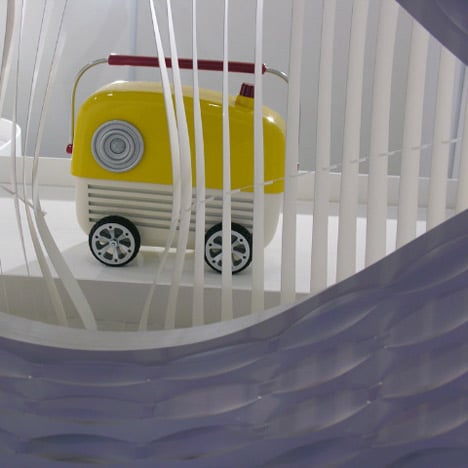Michigan studios Rootoftwo and PLY Architecture have housed their conceptual models of future kitchen appliances in a paper teahouse at the National Museum of Modern Art in Kyoto, Japan. Update 31/07/11: see Dezeen's top ten stories about robots.
The objects' aesthetics are a combination of iconic domestic appliances and classic vehicles.
A Dualit toaster, Bush TR82 radio and KitchenAid mixer have been crossed with an Airstream trailer, GM Futureliner bus and Dymaxion car respectively.
The woven paper structure has small eye-shaped openings and takes its dimensions from a traditional Japanese tea house. It will be on display until August 22.
Here's some more from the designers and architects:
THR_33 (Tea House for Robots) by rootoftwo and PLY Architecture is currently on display in the exhibition:
Trouble in Paradise/Medi(t)ation of Survival
The National Museum of Modern Art, Kyoto, Japan. Friday, July 9 – Sunday, August 22, 2010.
THR_33 (Tea House for Robots) is comprised of a responsive environment and a group of robotically-enhanced domestic appliances. Imagine if your radio could tune into any frequency that had ever been broadcast. What would we hear? Imagine if your toaster could remember how you liked your toast, or your entire family’s preferences. What if your kitchen mixer could prepare ingredients based on downloadable techniques and recipes – where you just choose the recipe/technique, add the ingredients and it does the rest? What if household appliances in the future recharged at solar powered light wells and required time to play in order to learn?
THR_33 imagines all this and proposes that as our appliances become smart we will change the way we live and come to think of them. In the manner of Jonathan Chapman's 'Emotionally Durable Design' (2005) perhaps we would cherish these products more than the throwaway gadgets we currently create. In our speculative 'home of the future' appliances have evolved to become part of the family.
THR_33 questions how we will relate to these autonomous and responsive environments and appliances. THR_33 mixes the sophistication of contemporary smart and super phones, with the design aesthetic of iconic industrial products to produce appliances we want to live with. The 'Robots' (TST_003, RDO_002, and MXR_011) all have unique traits, behaviors and interactions. The interactions move between user and object, object and space. TST_003 is a toaster, RDO_002 is a radio and MXR_011 is a stand mixer. They all have been conceived as sense-enabled robots with speculative features. All 3 robots are hybrids of vehicles and products: TST_003 = Dualit + Airstream; RDO_002 = Bush TR82 + GM Futurliner and MXR_011 = KitchenAid Mixer + Dymaxion Car.
The 'tea house' structure conforms to the traditional dimensions of a Japanese tea house of 9’ x 9’ x 6', the space provides a series of interactions between user and space, space and robots. The tea house "eyes" are driven by the OMRON Smile Scan. The Smile Scan uses OMRON’s OKAO Vision face-sensing technology. This technology relies on facial data gathered from over 1 million people, accumulated through over 10 years of study of the human face. The system measures the degree of a person’s smile from a camera-recorded facial image based on key point movements from 0% to 100%. In THR_33 this percentage controls how much the tea house "eyes" open. The tea house skin was laser cut and 'stitched' together. The skin is made from 2 layers of precisely cut synthetic paper pieces that interlock with each other.
Rootoftwo (John Marshall and Cezanne Charles)
PLY Architecture (Karl Daubmann and Craig Borum)
See also:
.
| Multi-sensorial Gastronomy by Philips Design | Paper Tea House by Shigeru Ban |
Dezeen’s top ten: food |

